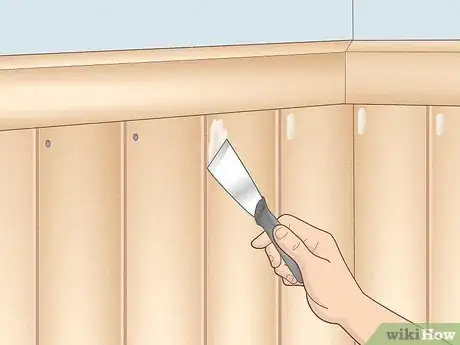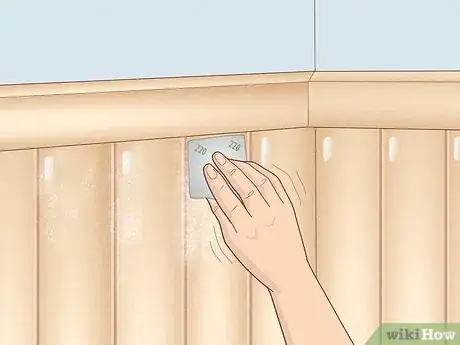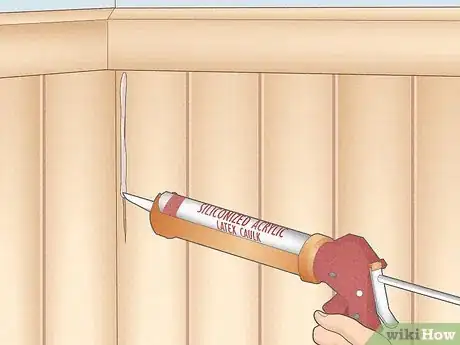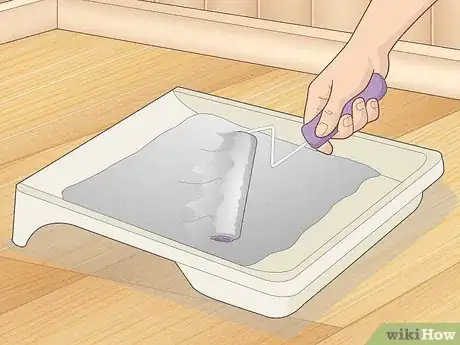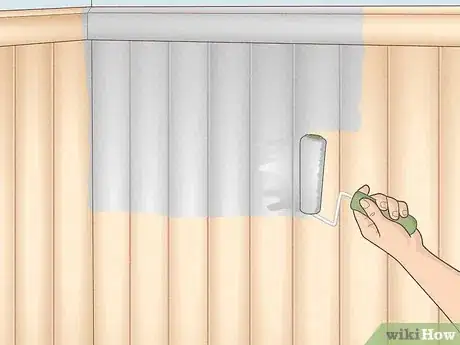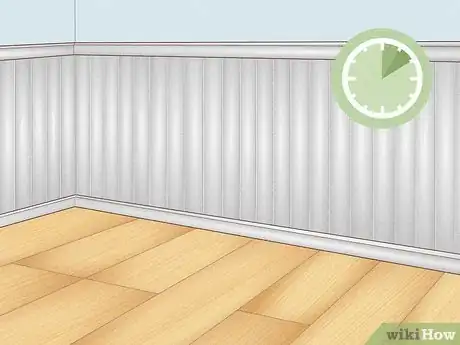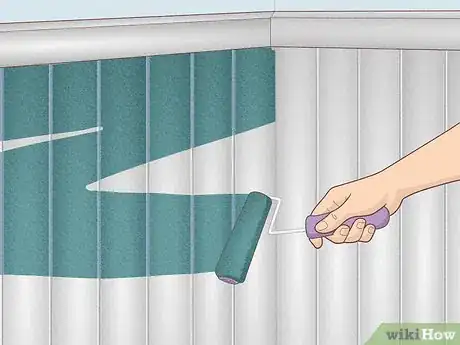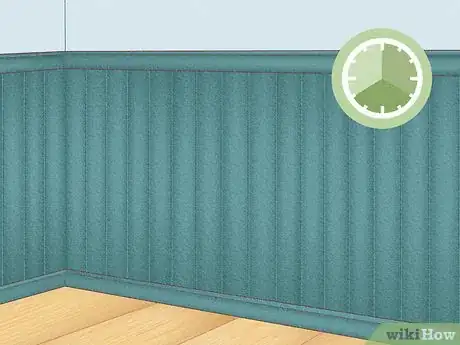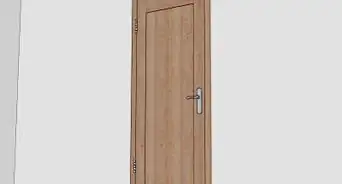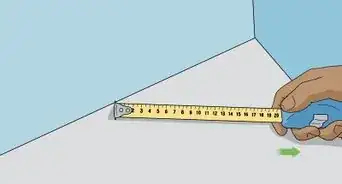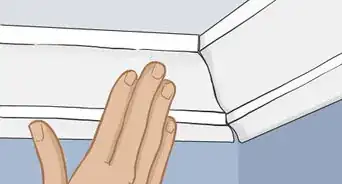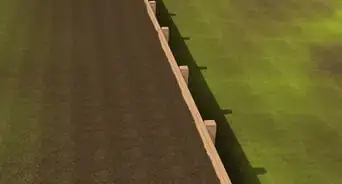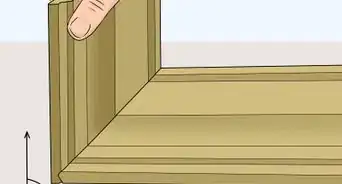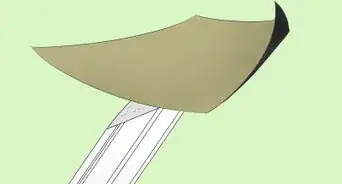This article was co-authored by Archie Guerrero. Archie Guerrero is a Commercial and Residential Painting Specialist and the Operations Manager for DGP Painting in Austin, Texas. With a decade of experience, Archie specializes in interior and exterior painting and staining, cabinet refinishing, and wallpaper and popcorn removal. DGP Painting offers clients environmentally friendly paint materials and top-of-the-line paint products. DGP Painting has an A+ rating with the BBB and has been in Austin’s “Best of the Best.”
There are 19 references cited in this article, which can be found at the bottom of the page.
This article has been viewed 15,907 times.
If you’ve recently had beadboard accents installed in your home, you may be wondering about the best way to paint them in order to achieve a more customized look. While there are several techniques for painting beadboard and other styles of wood paneling, the fastest, most efficient method is to apply a heavy preliminary coat with a roller. You can then go back and use a handheld brush to smooth out the textured finish and work the paint deeper into the paneling’s signature grooves.
Steps
Patching and Caulking Beadboard
-
1Patch nail holes and other damaged spots with a durable wood filler. For each hole you encounter, scoop up a dime-sized glob of wood filler with the tip of a flexible putty knife and carefully work it into the hole. Then, use the flat side of the blade to spread the compound until it’s smooth and level.[1] [2]
- Overfill the holes slightly so that the surface around them appears raised. Wood filler has a tendency to shrink a bit as it dries.[3]
- It’s important to use wood filler for this step rather than spackle, as spackle is designed for use on drywall and beadboard is made from pressed composite wood.
-
2Allow the filler compound to dry to the touch. Most wood fillers are designed to dry within 15-30 minutes, but some could take as long as 8 hours to set completely. Avoid handling the compound in the meantime. For more specific information on drying times, check the instructions provided on the packaging of the specific product you’re using.[4]
- If you touch the filler while it’s still wet, you could accidentally leave behind small depressions or other imperfections and be forced to repeat the process to correct your mistake.
- The compound will harden as it sets up, blending in with the surrounding surface to create a seamless appearance.
Advertisement -
3Sand the filled holes smooth with high-grit sandpaper once it dries. Run the sandpaper over the dried compound using tight, circular strokes with moderate pressure. Keep sanding until the mounded filler is level with the surface of the surrounding paneling. There should be no significant difference between the two materials in terms of depth.[5]
- When you’re finished sanding, give the patched surface a quick wipedown with a damp cloth or paper towel to remove loose dust and debris.
- A sheet of sandpaper with a grit somewhere between 120- and 220- will work best for this task.[6]
-
4Seal all cracks and seams around the beadboard paneling with latex caulk. Squeeze a thin line of caulk into any spots where you notice a gap between the paneling and the edges of neighboring surfaces. This will usually include interior corners, the joints between panels, and the strip where the bottom of the paneling runs up against the baseboards.[7]
- Wait until the caulk solidifies and loses its tackiness before moving on. With most sealants, this will take around 20-30 minutes.
Warning: Only use as much caulk as necessary to completely fill in each area. Heaping it on too thick could cause visible textural inconsistencies in the surface after it’s been painted.
Priming the Surface
-
1Sand the paneling lightly with a sheet of 60-100-grit sandpaper. Run the sandpaper along the length of each individual board, being sure to follow the wood’s natural grain pattern.[8] When you reach a groove between two boards, drape the sheet over your fingertips to reach down deeper. Afterwards, wet a soft cloth or paper towel and wipe the entire surface to pick up as much dust as possible.[9]
- Spongey sandpapers will do a better job of getting down into the contours of the beadboard that ordinary types.
- Scuffing up the wood will encourage the primer stick, which will in turn help your paint to coat properly.
-
2Load your roller heavily with a water-based interior primer. Pour about 2 inches (5.1 cm) of primer into a paint tray or similar shallow container. Dip your roller into the primer and move it back and forth to thoroughly saturate the nap. Let the excess primer drip off into the tray before getting started.[10]
- To make swifter work of priming and painting, fit your roller with a wool cover with a 3⁄8–3⁄4 in (0.95–1.91 cm) nap that will hold lots of primer.[11]
- Loading your roller a little heavier than you would for ordinary painting jobs will make it easier to work the primer into the slender grooves in the beadboard.
Tip: Consider using an oil-based primer instead if your beadboard paneling is in a part of your home that’s subject to frequent changes in temperature or high humidity levels, like the kitchen or a hallway near one of the entrances.[12]
-
3Roll the primer onto the paneling horizontally. Press your roller into the surface firmly and glide it from side to side with short overlapping strokes. This technique makes it possible to push much more primer into the grooves than you could using vertical strokes. As you roll, keep an eye out for missed spots on the face of the boards and pause to go back over them if necessary.[13]
- Don’t worry too much about drips or inconsistent coverage. You’ll be taking care of these issues in the next step.
-
4Brush vertically along the grooves in the paneling to even out the primer. While the primer is still wet, take a small angled brush and glide it up and down the length of each groove. This will cover any spots that your roller couldn’t quite get to. It will also smooth over any stippling left behind by the textured roller for a flatter, more seamless finish.[14]
- It may help to load your brush with a small amount of fresh primer when going over areas with especially light or spotty coverage.
- A 2 1⁄2 in (6.4 cm) angled rat tail sash brush is ideal for painting surfaces like beadboard that have lots of intricate contours.[15]
-
5Proceed in 3 ft (0.91 m) square sections until you’ve primed the entire surface. Work your way along the paneling from end to end, top to bottom. Restricting yourself to more compact sections will give you plenty of time to apply the primer, back-brush the grooves, and review your handiwork before the primer begins to dry.[16]
- Reload your roller with fresh primer each time you start a new section.
-
6Give the primer 1-2 hours to dry. It’s crucial that your paint have a nice, dry surface to adhere to. Fortunately, water-based primers tend to dry rather quickly. In a couple short hours, you’ll be ready to get painting![17]
- Oil-based primers typically take several hours longer to dry than water-based ones. If you opted for an oil-based primer, it will likely need 8-12 hours to set to the point where it can be painted over safely.
Painting the Paneling
-
1Load your roller with a liberal amount of paint. Fill an unused paint tray with roughly 2 inches (5.1 cm) of your paint of choice and coat the outside of your roller cover thoroughly, just like you did during the priming phase. Then, drain any excess paint clinging to your roller so it doesn’t end up anywhere it’s not supposed to be.[18]
- Either clean the roller you used to prime the surface with soap and warm water and allow it to air-dry prior to painting or slide on a separate roller altogether. For best results, use a roller cover with nap at least 3⁄8 inch (0.95 cm) high.
- You can use any kind of interior paint you like here, but many experts recommend an oil-based trim paint with a satin or semi-gloss finish for long-lasting color capable of standing up to moisture, sunlight, and general wear and tear.[19]
- When using a roller to paint wood paneling lined with deep crevices, it’s always a good idea to start with more paint than you think you realistically need.
-
2Roll the paint onto the beadboard laterally. Starting somewhere on the upper part of the surface, drag your roller across the boards in an overlapping ‘Z’-shaped pattern. Work your way across the paneling 3 ft (0.91 m) square sections.[20]
- Painting horizontally as opposed to straight up and down will help guarantee more complete coverage, even down into the deepest recesses of the intermittent grooves.
-
3Back-brush the grooves in the paneling to even out the paint. As soon as you finish painting one section of the beadboard, grab your trusty angle brush and go over the wet paint using fluid up-and-down motions. The result will be a velvety-smooth base coat that’s free of imperfections.[21]
- Align the center of your brush with the middle of each groove. That way, the bristles on either side will even out the paint on the faces of the adjacent boards for an effortless overlapping effect.
- You can also use your brush to cut in around corners and trim if you don’t want to risk getting too close with your roller.
Tip: Turning your brush sideways can improve your coverage inside grooves that are more than about 1⁄4 inch (0.64 cm) deep.
-
4Let your initial coat dry for 4-8 hours. Generally speaking, water-based paints will dry to the touch in about one hour and be ready to receive a second coat in 3-4, while oil-based paints will need closer to 6-8 hours of drying time. Be sure to follow the guidelines laid out on the label of the particular paint that you’ve chosen for your project.[22]
- Switch on the ceiling fan, leave your air conditioner running, or open a few doors or windows to ventilate your work area and speed things along.
- Take care not to touch or allow anything to come into contact with the surface while the paint is still wet. This may require you to set up barricades to keep small children, curious pets, and unsuspecting visitors at a safe distance.
-
5Repeat the process to apply one or more follow-up coats. In most cases, it will only take a couple of coats to achieve a smooth, flawless finish.[23] If you think your surface needs it, you can slap on a third coat to ensure uniform color. When you’re done, you’ll have an eye-catching, pleasantly homey accent piece to show for your efforts.[24]
- Allow each of your follow-up coats to dry for at least 4-8 hours before rolling on a subsequent coat.
Things You’ll Need
- Wood filler compound
- Flexible putty knife
- 120-220-grit sandpaper
- Latex caulk
- 60-100-grit sandpaper
- Paint roller
- Water- or oil-based interior primer
- Water- or oil-based interior trim paint
- 3⁄8–3⁄4 in (0.95–1.91 cm) wool nap roller cover
- 2 1⁄2 in (6.4 cm) angled rat tail sash brush
- Soft cloth or paper towel
- Water
- Warm water and mild liquid dish soap (optional—for cleaning painting tools)
- Acetone (optional—for cleaning painting tools)
References
- ↑ Archie Guerrero. Commercial & Residential Painting Specialist. Expert Interview. 17 June 2021.
- ↑ https://www.bobvila.com/articles/how-to-fix-nail-holes/
- ↑ https://www.thisoldhouse.com/woodworking/21017152/how-to-choose-and-use-wood-filler
- ↑ https://www.bobvila.com/articles/how-to-use-wood-filler/
- ↑ https://www.remodelista.com/posts/how-to-fix-nail-holes-in-your-wall-remodeling-101/
- ↑ https://www.bobvila.com/articles/2145-quick-tip-choosing-sandpaper/
- ↑ https://www.youtube.com/watch?v=Bw13b8rLCIc&feature=youtu.be&t=17
- ↑ Archie Guerrero. Commercial & Residential Painting Specialist. Expert Interview. 17 June 2021.
- ↑ https://www.bhg.com/decorating/home-accessories/wall-art/how-to-paint-wood-paneling/
- ↑ https://sawdustgirl.com/quick-and-easy-way-to-paint-beadboard/
- ↑ https://www.bobvila.com/articles/best-paint-roller/
- ↑ https://www.thisoldhouse.com/walls/21015062/installing-painting-wood-beadboard
- ↑ https://www.younghouselove.com/how-to-paint-wood-paneling/
- ↑ https://www.thisoldhouse.com/walls/21015062/installing-painting-wood-beadboard
- ↑ http://www.acmehowto.com/paint/brush-types.php
- ↑ https://www.youtube.com/watch?v=Bw13b8rLCIc&feature=youtu.be&t=61
- ↑ https://www.paintspraypro.com/how-long-does-it-take-primer-to-dry/
- ↑ https://sawdustgirl.com/quick-and-easy-way-to-paint-beadboard/
- ↑ https://thecardswedrew.com/paint-beadboard/
- ↑ https://www.younghouselove.com/how-to-paint-wood-paneling/
- ↑ https://www.youtube.com/watch?v=Bw13b8rLCIc&feature=youtu.be&t=84
- ↑ https://www.bobvila.com/articles/how-long-does-it-take-paint-to-dry/
- ↑ Archie Guerrero. Commercial & Residential Painting Specialist. Expert Interview. 17 June 2021.
- ↑ https://countrylivinginacariboovalley.com/paint-wood-panelling/
